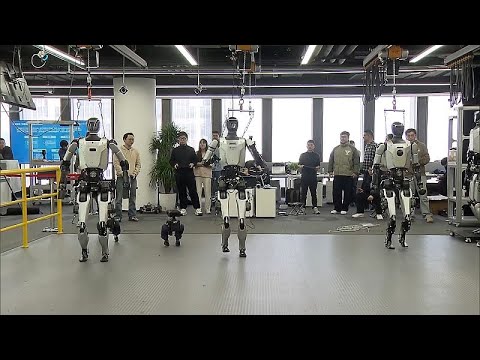| IN BRIEF |
|
China is set to make a significant leap in the field of artificial intelligence with the opening of its humanoid robot training center. This center, a world first, seeks to revolutionize how robots learn and interact with their environment. By focusing on the acquisition of fundamental skills through the repetition of human actions, this facility promises to generate vast amounts of data that will feed into an AI “super brain.” Let’s explore how this ambitious project could redefine the robotics industry.
The Humanoid Robotics Innovation Center
The National and Local Co-built Humanoid Robotics Innovation Center in Shanghai is a massive project covering over 5,000 square meters. Its mission is to promote widespread data sharing and utilization among robot developers. More than 100 types of robots from a dozen companies are already in training, aiming to create a robust database for industrial, medical, and agricultural applications. This center is designed to overcome key challenges in R&D for humanoid robotics, such as shared technologies and industrial ecosystems.
Xu Bin, the center’s general manager, emphasizes the importance of massive data generation and a shared ecosystem for robots. The variety of designs and functional modules from different manufacturers produces heterogeneous datasets that are often incompatible. The center aims to harmonize these data to enhance efficiency and innovation in the field.
Bridging the Gaps in Embodied Intelligence
To gather motion datasets, a team of human trainers continuously performs repetitive actions, sometimes hundreds of times a day. This allows robots to replicate these movements and improve. Even slight variations in the shape or angle of an object create unique data points that help robots adapt to subtle environmental changes.
The center focuses on ten major application scenarios, covering industrial and domestic tasks as well as tourism services. These tasks are further divided into subtasks such as folding clothes, assembling or organizing objects, and cleaning heavy machinery in hazardous environments. In the testing phase, the center is already generating between 20,000 and 30,000 data entries per day. Once fully operational, it could reach up to 50,000 entries per day, with a goal of over 10 million real data entries by the end of the year.
Future Collaboration and the “Super Brain” Model
One of the long-term goals of the center is to create a data exchange platform that allows robot developers to share scenario-specific data, such as for household appliances or healthcare, to minimize redundancies. Yang Zhengye, market systems director, notes that the data collection from various humanoid robots will serve to develop a versatile embodied intelligence model.
This “super brain” model could guide robots from different manufacturers, thus facilitating multi-robot collaboration and collective updates. China’s push for humanoid robotic innovation is part of a broader shift towards advanced AI applications. Stakeholders hope that the widespread availability of inter-company data will accelerate R&D while reducing overall costs.
Accelerating Robot Growth
The training center illustrates how China seeks to cultivate an ecosystem for advanced robotics and AI. By systematically gathering and refining movement data across various robotic platforms, engineers can refine algorithms and share advancements much more rapidly than in a siloed environment.
According to Xu, the facility also represents a “fundamental infrastructure for the development of artificial intelligence,” effectively linking hardware, software, and massive data collection into a continuous pipeline. Industry observers are closely monitoring the center, which is expected to reach full capacity this summer. What will be the next steps to integrate these advancements into our daily lives, and what challenges remain for widespread adoption?








